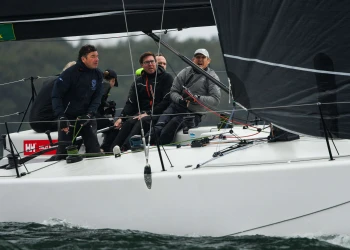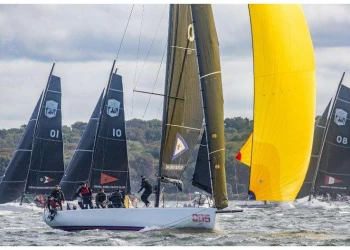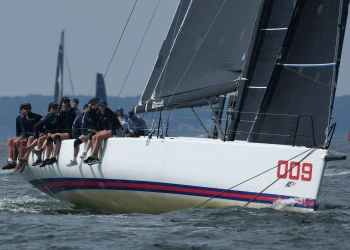American Magic's Tim Hornsby, the one they call Paddles
He's the one they call “Paddles.” The nickname was all but inevitable for U.S. Olympic kayaker-turned-grinder Tim Hornsby (Atlanta, Ga.), one of the elite athletes recruited from a broad range of sporting backgrounds to help power New York Yacht Club American Magic around America’s Cup racecourses.
Hornsby represented the United States in the 200m Canoe Sprint kayaking event at the London 2012 Games, and narrowly missed selection for both Beijing 2008 and Rio 2016. Training for years to achieve an optimal balance of power, weight, endurance and speed, sprint kayaking athletes are ideally suited for boosting Cup contenders. American Magic has two sailors that come from the kayaking world, with both Hornsby and four-time Olympian, World Champion and 2017 Louis Vuitton Cup veteran Anders Gustafsson (Jönköping, Sweden) on the roster.
Of the eleven sailors onboard the team's AC75 racing boat, DEFIANT, eight are tasked nearly full time with “grinding,” the process of generating the immense hydraulic pressure needed to operate an AC75’s systems. An innovative pedal-based grinding approach, the “cyclor” system, helped win New Zealand the Cup in 2017. With cyclors banned for Auckland 2021, the focus has returned to the hand-turned pedestals that have been found onboard racing yachts for decades. This time, though, those pedestals are powering a nine-ton hydrofoiling monster without precedent in the 169 year history of the Cup.
A kid from a landlocked American city might seem like an unlikely candidate to ascend to the pinnacle of two water-based sports, but Hornsby was drawn to boats from an early age. “I was kind of a weird kid in that I was always into what could be described as ‘not your mainstream sports,’” he recalled. “I lived in Atlanta, so there wasn't a lot of water there, and I was trying to look for opportunities to be involved in watersports. I ended up going to a summer camp for kayaking when I was pretty young, around 11. That camp was at the Atlanta 1996 Games venue, and it turned out that the Canadian Olympic coach had been hired. It was really inspirational. He helped convince me to make the hourlong drive each way to go to this training facility and pursue an Olympic dream."
Hornsby’s Olympic career was highlighted by many national titles, a 2012 Games appearance, World Cup medals, U.S. records, and more. But after a serious injury derailed his Team USA selection for Rio at the last minute, another challenge beckoned.
“A good kayaking friend of mine, Anders, who is now my teammate with American Magic, was competing for Artemis in 2017,” explained Hornsby. “During that whole Rio 2016 Olympic cycle, I was living with his family. Anders would come back from America's Cup training, and tell us all about it. I just couldn’t get enough. When I heard there was going to be an American team for the next Cup, I was immediately emailing Terry, Coach [James Lyne] and anybody on the team who would respond.”
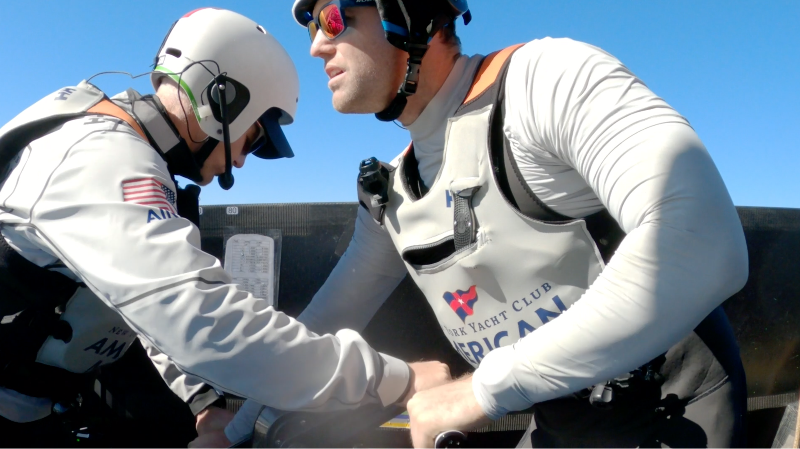
The AC doors did not immediately swing open. The candidate pool was large, and others with more sailing-focused backgrounds, and from other sports, got a look from the team’s athletic performance staff in the early stages of the campaign. “I’d say I was pretty persistent in trying to get an opportunity,” recalled Hornsby. “Eventually the team said 'Let’s do a trial.’ So I drove down to Boston, and bought a grinding machine. When I got home, I then found out the team wanted me to do my trial just a week later. I had just bought this thing! I had just started training, but I was nowhere near the shape I thought I would need to be in. But I jumped at the opportunity and basically after two days of testing they told me it went well. Not knowing what was next, I went home and put all of my energy into training in the hope I would have an opportunity to join the team.”
When the team’s 38-foot test platform, the Mule, was launched in late 2018, no grinders were needed to sail onboard the battery-powered, five-person boat. Instead, the focus for “the engine room,” the more than a dozen athletes slated to turn handles and trim sails onboard the forthcoming AC75, was on training and systems development. “Every day we were going up to Bristol (Rhode Island) to be a part of the boat build [for DEFIANT] and the development of some of the systems,” said Hornsby, who studied Aerospace Engineering at U.C. San Diego. “So I got to really see the process, sit in on the meetings, and listen to what was going on. It was such a talented group of people so I was excited when I eventually got some ‘side science projects’ to work on. They weren’t related to building the boat, but they were related to how we might figure out some of the systems. It was a really cool opportunity to do some engineering work and get my feet wet with the America’s Cup. I think that period in Bristol helped set the foundation of working every day with the build and design team.”
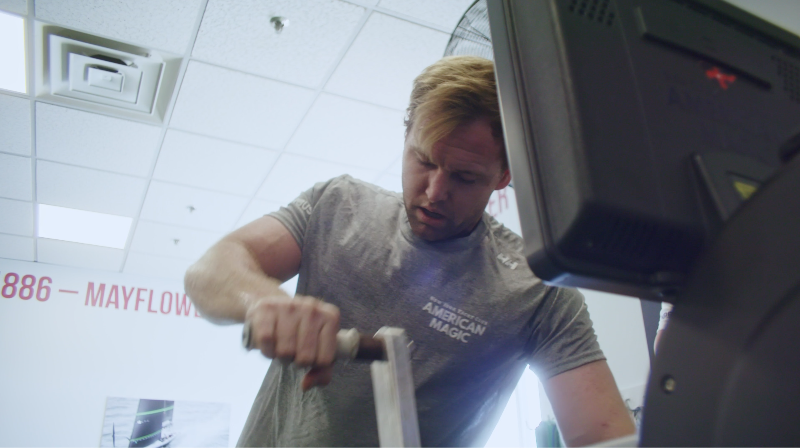
Hornsby notes that the culture inside American Magic leaves a lot of room for team personnel to expand their roles and bring in fresh ideas. “The team gives you a lot of space to do your job. You get told at first that this is what your role is going to be, but sometimes they don't really tell you exactly how you should do that role. It's kind of up to you to know your business. This is the first time a boat like this has ever been sailed so the first time we sailed on DEFIANT, we had a limited playbook. There was still uncertainty in how the systems would work. That stage was all about taking in as much info as possible, talking to guys like Cooper [Dressler], Dan [Morris], [Luke] “Payno” [Payne], Jim [Turner], and Trevor [Burd] and trying to get a feel of what my role and the boat might be like. Honestly, I think I talked to just about everyone!”
While others on the team brought vast sailing resumes to the table, Hornsby brought a deep understanding of body movement mechanics, power generation and cardiovascular efficiency that were directly applicable to his role. “Grinding is like paddling in that both motions are very dynamic. Kayakers have reasonably strong arms, but it's not your arms that generate most of the power. It’s your legs, core, and back. So you use as much of your body and as much of your bigger muscle groups as you can to move the kayak or the handles.” Hornsby also found that some of the familiar warning signs of inefficient form were present in his new sport. “If you feel like your arms are hurting, you know you're doing something wrong. If your forearms or smaller muscles are limiting your power output, you're not able to get to your real potential.”
As Hornsby evolves into an elite grinder, grinding itself is evolving during the foiling era of sailing. What is needed aboard a boat like the Maxi 72 BELLA MENTE, where Hornsby did some cross-training for American Magic, versus what is needed for an AC75 differs significantly. “On a boat like BELLA MENTE, you might need a 15 or 30 second power burst for a maneuver or kite drop, followed by a short rest before the next maneuver. This was more reflective of the IACC Version 5 boats [used in 2007]. As the Cup has changed, it's become a lot more [about] continual grinding and “producing oil” to move things on the boat. A three second power output isn't so important anymore versus a forty-five minute power output. So I think it’s changed a lot, it’s still pretty new, and a lot more will continue to change as we all work to get better.”
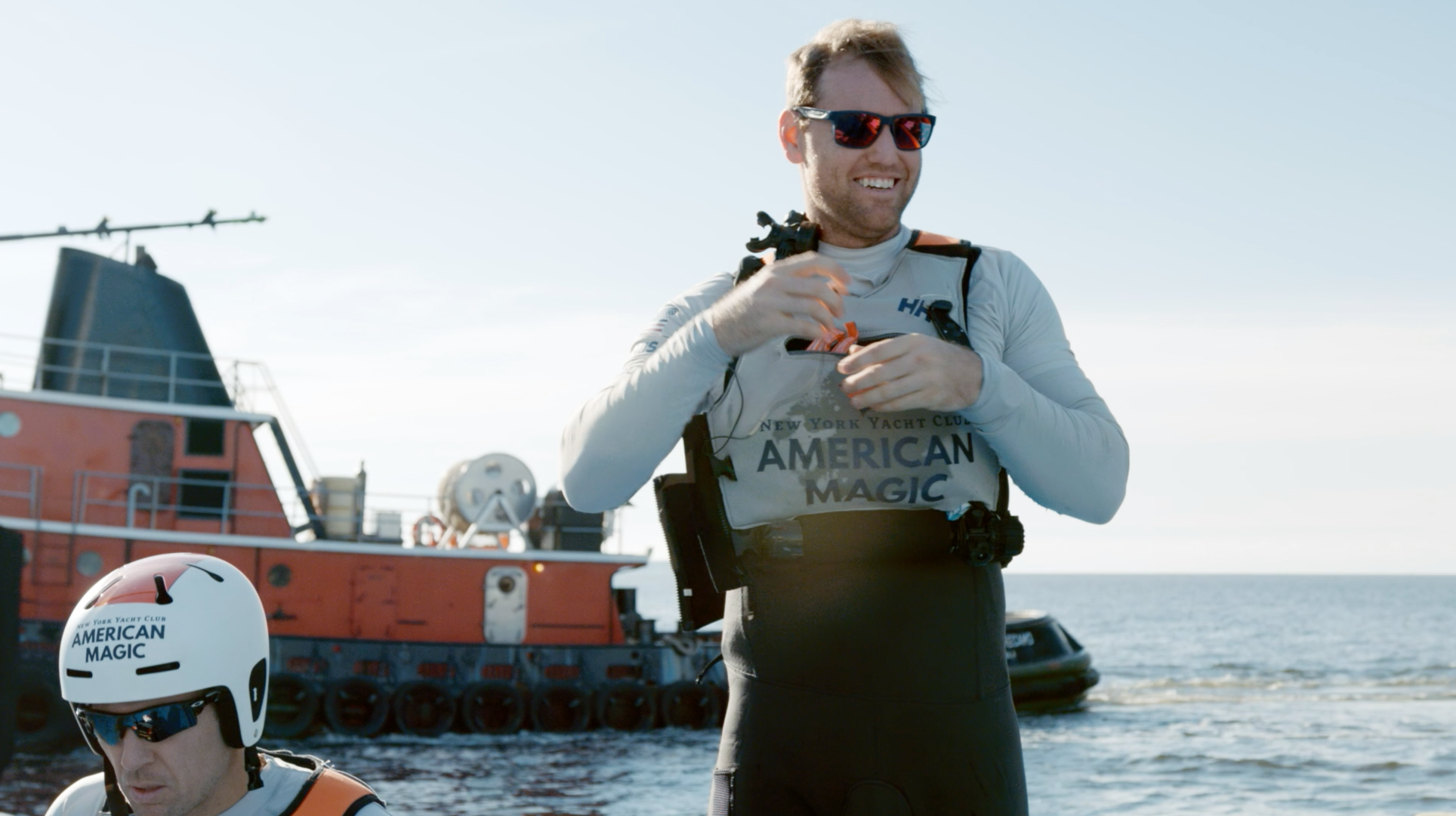
As American Magic gets ever closer to arriving in Auckland, the U.S Challenger is looking forward to being in proximity to other teams, and getting closer to that first opportunity to race. “I am super excited for the racing,” admitted Hornsby. “My mentality has always been to build a strong ‘foundation of process' during training, so that when you go race, you're just doing exactly what you've done every day. Nothing has to be different. There's obviously an extra intensity that comes naturally from racing, but in general I think we just have to keep executing what we do in practice every day.”
The boats have gotten slightly larger and faster for Hornsby, who started in a 17-foot kayak and ended up on a 75-foot hydrofoiling monohull. Nevertheless, the change that stands out the most for him is the switch from individual competitions and achievements to being part of a team of 140. “It’s really cool when something good happens on the boat,” he said. “Everybody's calm and collected, no matter what, and I think it'll be the same for racing. Being on a big team is a very different environment for me, but I've always loved supporting my training partners over the years. By really working together as a group, you're able to raise the level so much higher. We can't wait to go racing. It's going to be awesome.”





